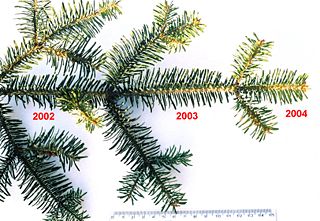
In botany, an evergreen is a plant which has foliage that remains green and functional through more than one growing season. This also pertains to plants that retain their foliage only in warm climates, and contrasts with deciduous plants, which completely lose their foliage during the winter or dry season.

Sclerophyll is a type of vegetation that has hard leaves, short internodes and leaf orientation parallel or oblique to direct sunlight. The word comes from the Greek sklēros (hard) and phyllon (leaf).

The snowshoe hare, also called the varying hare, or snowshoe rabbit, is a species of hare found in North America. It has the name "snowshoe" because of the large size of its hind feet. The animal's feet prevent it from sinking into the snow when it hops and walks. Its feet also have fur on the soles to protect it from freezing temperatures.

Darevskia is a genus of wall lizards of the family Lacertidae living in the Caucasus, Iran and Turkey in forest and grassy habitats with numerous rock outcrops. Among rock lizards, 7 parthenogenetic species are known.
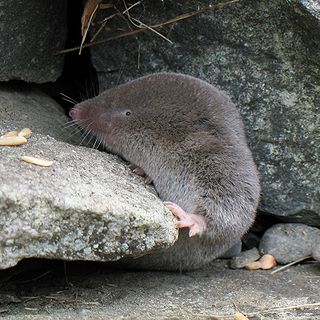
The northern short-tailed shrew is the largest shrew in the genus Blarina, and occurs in the northeastern region of North America. It is a semifossorial, highly active, and voracious insectivore and is present in a variety of habitats like broadleaved and pine forests among shrubs and hedges as well as grassy river banks. It is notable in that it is one of the few venomous mammals. The specific epithet, brevicauda, is a combination of the Latin brevis and cauda, meaning "short tail".
The genus Phenacomys is a group of North American voles. The genus name comes from the Greek for "imposter mouse."
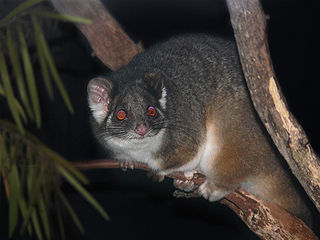
The common ringtail possum is an Australian marsupial. It lives in a variety of habitats and eats a variety of leaves of both native and introduced plants, as well as flowers, fruits and sap. This possum also consumes a special type of faeces that is produced during the daytime when it is resting in a nest. This behaviour is called caecotrophy and is similar to that seen in rabbits.
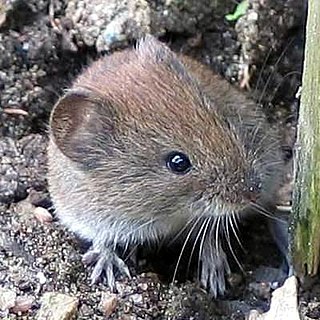
The bank vole is a small vole with red-brown fur and some grey patches, with a tail about half as long as its body. A rodent, it lives in woodland areas and is around 100 millimetres (3.9 in) in length. The bank vole is found in much of Europe and in northwestern Asia. It is native to Great Britain but not to Ireland, where it has been accidentally introduced, and has now colonised much of the south and southwest.

Peromyscus maniculatus is a rodent native to North America. It is most commonly called the deer mouse, although that name is common to most species of Peromyscus, and thus is often called the North American deermouse and is fairly widespread across the continent, with the major exception being the southeast United States and the far north.

The Atlantic titi or masked titi is a species of titi, a type of New World monkey, endemic to Brazil.

Ochyroceratidae is a six-eyed spider family, with 165 described species in ten genera. They are common inhabitants of caves and the tropical forest litter of South Africa, the Caribbean, Asia and South America. Considered an ecological counterpart of the Linyphiidae of the northern temperate zone, species are especially diverse in the Indo-Pacific region.
Theotima is a genus of small spiders in the family Ochyroceratidae.

The fauna of Puerto Rico is similar to other island archipelago faunas, with high endemism, and low, skewed taxonomic diversity. Bats are the only extant native terrestrial mammals in Puerto Rico. All other terrestrial mammals in the area were introduced by humans, and include species such as cats, goats, sheep, the small Asian mongoose, and escaped monkeys. Marine mammals include dolphins, manatees, and whales. Of the 349 bird species, about 120 breed in the archipelago, and 47.5% are accidental or rare.

The narrow-nosed planigale is a species of very small marsupial carnivore of the family Dasyuridae.

Gleaning is a feeding strategy by birds in which they catch invertebrate prey, mainly arthropods, by plucking them from foliage or the ground, from crevices such as rock faces and under the eaves of houses, or even, as in the case of ticks and lice, from living animals. This behavior is contrasted with hawking insects from the air or chasing after moving insects such as ants. Gleaning, in birds, does not refer to foraging for seeds or fruit.

The southeastern shrew is a species of mammal in the family Soricidae. It is found in the southeastern United States.

Trichoniscus pusillus, sometimes called the common pygmy woodlouse, is one of the five most common species of woodlice in the British Isles. It is acknowledged to be the most abundant terrestrial isopod in Britain. It is found commonly across Europe north of the Alps, and has been introduced to Madeira, the Azores and North America.
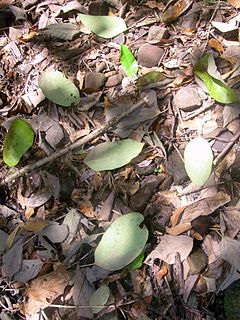
Litterfall, plant litter, leaf litter, tree litter, soil litter, or duff, is dead plant material that have fallen to the ground. This detritus or dead organic material and its constituent nutrients are added to the top layer of soil, commonly known as the litter layer or O horizon. Litter is an important factor in ecosystem dynamics, as it is indicative of ecological productivity and may be useful in predicting regional nutrient cycling and soil fertility.

Triaeris stenaspis is a species of spider in the family Oonopidae, with a pantropical distribution. It is also found in Iran and has been introduced into Europe. A very small spider, with a maximum body length of under 2 mm (0.08 in), it has been shown to prey successfully on springtails. Only females have ever been found, and the species may be parthenogenetic, being able to produce female offspring from unfertilized eggs.
Corybas cryptanthus, commonly known as the hidden spider orchid or icky, is a species of terrestrial orchid endemic to New Zealand. It has no obvious leaves and the mostly white flower is usually buried in leaf litter. The plant is usually only detected by its fruiting capsule which is borne on a stem which elongates up to 280 mm (10 in) high.
















